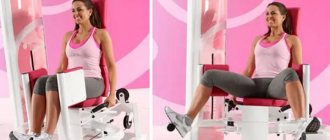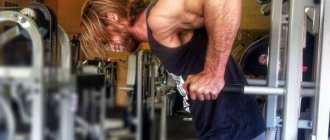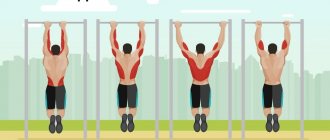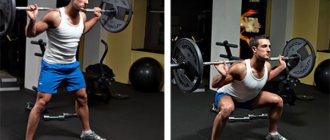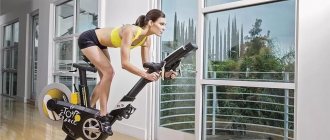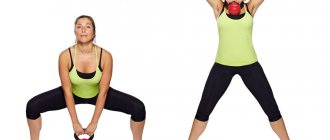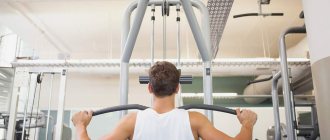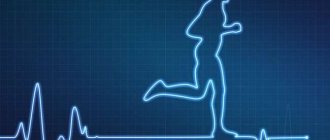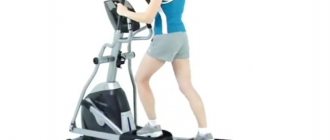Why was the ellipsoid invented?
The treadmill has always been a good way to pass the time. Useful and once again useful - this is physical exercise. But what to do when a person cannot run? Yes, it happens. For example, when he has flat feet and does not have orthopedic insoles (only over the last 20–30 years has it become possible to model and create individual insoles). Or when a person has sore joints.
Therefore, sports industry engineers decided to go further and set a goal to come up with something that would not put much strain on the joints, but would force the heart and muscles to work for the benefit of health and weight loss. This is how exercise bikes were born. First simple, then more intricate. Modern technologies have made it possible to install mp3 players, heart rate monitors, and various sensors on exercise bikes.
What if it’s not enough to just pedal with your feet? Hands are not involved, weight loss alone is not enough. Where can the arms work, as in running, without any shock-absorbing load (jumping) on the legs? So they came up with a design where there are 2 poles and something like skis. Movement is carried out through the arms, body and legs.
My legs seem to be pressing my “skis” into the floor. When you press down on one ski, the other one rises. And so time after time. In addition, by moving the poles towards you, or pushing them away one by one, you also force the “skis” to move.
The result was an ellipsoid. Many people say that the ellipsoid imitates skis, but this is not entirely true. Those who are familiar with classic skiing will see the differences. Still, the skis glide on the snow. And here you press the pedals to the floor.
When will the first results appear after training on the ellipse?
You can notice visible changes after a few weeks of regular cardio exercise. Problem areas are tightened gradually, the process of burning calories also takes place, but endurance increases more quickly. A person can feel how easy it is for him to climb stairs.
Depending on which muscles are worked on the elliptical trainer, there will be changes. If you train only your buttocks, nothing will change in your shoulders and stomach. Weight also does not decrease immediately. On average, an ellipsoid helps to get rid of 1 to 6 kg per month.
What muscles work on the elliptical?
To be precise, the ellipsoid imitates Nordic walking. For those who don’t know, this is a type of walking in which you hold sticks in your hands and, as it were, push off with them from the surface on which you are walking.
Only the ellipsoid has a nuance - when you pull these sticks towards you, the pedals also move after them. Thus, the elliptical trainer allows you to work the muscles of almost the entire body. And to be more precise:
- The hands pull and push the “sticks”, the shoulder girdle works. The back and chest also participate in the movement of the “sticks” or handles.
- The legs press the pedals, the hips and buttocks work.
- The core muscles provide stability to the entire body.
When leaning forward
The inclined body reduces the impact on the spine - this is suitable for people suffering from osteochondrosis or who have suffered injuries. It is worth holding on to static handles, since the upper body is little involved. The more you press the pedals, the stronger the accent will be.
In this case, the elliptical trainer will help with cellulite, which muscles it affects:
- calf;
- quadriceps.
This is where excess fat accumulates in women and the “orange peel” appears; in men this area is also problematic - it lacks the desired muscle mass. The area is being well developed in the process. The lower legs remain toned and attractive.
How can an elliptical trainer help us?
Cardio
This common gym word isn't widely understood, but many know that "cardio" means "heart" (the Greek word is "kardia"). Trainers by this concept mean “beneficial load on the cardiovascular system.”
Long and monotonous movement involving the legs (running, walking, skiing) does magical things to our body:
- It wastes calories, that is, it forces the body to look for options to get energy to ensure movement.
- Stimulates the heart, accelerating its beat to more than 100 beats per minute. Below we will explain what this does and how it is useful for humans.
- Keeps all the muscles of the body in tone.
Why is it useful to stimulate the heart and “drive the blood”? For example, let's remember birds. The faster their heart beats, the shorter they live. Large mammals do not have this tendency. People who do cardio consistently live long enough and feel quite good.
That is, you need to train your heart. You just have to do it wisely.
When you pump blood, there is a dramatic improvement in blood supply to all peripheral cells of the body. And most importantly - the brain. And the longer you do cardio, the better everything is “washed” with blood. One caveat - there must be a lot of oxygen around you. Otherwise, such cardio can lead to unpleasant consequences (for example, a heart attack).
If you want regular cardio, the program is simple - exercise every day on the elliptical in a well-ventilated area for 15-20 minutes. Or 30 minutes three times a week. Or 40 minutes twice a week. Choose for yourself how many exercises to do to train on the elliptical trainer.
Weight loss
If you are ready to do anything to lose weight, we will gladden you - it is not so difficult. Even one ellipsoid is enough in terms of load. It will help you shed those extra pounds.
The weight loss program will greatly depend on your initial condition and contraindications.
If you have a number of diseases, for example:
- heart failure;
- diabetes;
- polyarthritis, strokes, heart attacks.
And a number of others, then you need to be careful with the ellipsoid. Consult your physician before starting exercise. Because each case will have its own limitations.
For everyone, recommendation number 1 is good aeration. If you are a fairly wealthy person, install an air conditioner. If not, ventilate the room well before starting the exercises.
Modern ellipsoids are very “smart”; their program is quite diverse. Choose the simplest and easiest thing to start with - observe the sensations. If you experience pain, stop exercising immediately.
As for people who do not have the listed diseases, work so that your average heart rate is 100–110 beats per minute. Several times during training you will need to increase your heart rate to 130–140, but not for long. We do not recommend doing this if you are over 40 years old.
To lose weight, exercise every day for 30 to 60 minutes. Turn on the TV, your favorite movie, music and exercise so that your T-shirt or tank top gets wet through. And listen to yourself. Pain in the heart - stop or slow down. Somewhere else, try to figure it out, but you don’t have to go through the pain. A burning sensation is one thing - it can be overcome (except for a burning sensation in the heart area - this is a very alarming sign). And no pain!
And don’t forget that these exercises are not magic. If you eat the same way as before, it is unlikely that you will be able to lose at least one kilogram.
Warm up before training
The previous 2 cases can be implemented perfectly at home. Now let's talk about why ellipsoids are in the gym.
To lose weight, to gain muscle mass, and in general before any workout with hardware, you need to warm up. And the warm-up program will be different for each case.
This requires at least 5 minutes of exercise on the elliptical. You may be offered a choice: a treadmill, an exercise bike, a jump rope, an open-air stadium, a punching bag. Choose! You need to sweat for five minutes. This is where you get your heart rate up to 130-140 beats per minute.
Try not to stand under air conditioning or exercise in stuffy rooms - this can cause health problems.
If you are working for mass, 5-10 minutes at a medium pace will be the best option.
If you go to the gym to lose weight, do cardio on the elliptical 30 minutes before training and 20-30 after, setting up a complex program with a graded load. This is the best option. And use the recommendations from the previous paragraph of this article. Overall, the program and exercises should align with your goals.
When pedaling in reverse direction
Direct and reverse rotation are different in technique, but similar in effect, exercises on an elliptical trainer, which muscles work:
- calf;
- femoral;
- gluteal
The method will allow you to diversify your cardio training and get rid of monotony. Your legs will become slimmer and more toned, creating an attractive shape. Cellulite will also be reduced. Suitable for both interval programs and independent exercises.
How to choose an ellipsoid for your home
Focusing on price in this matter is dangerous. The cheapest exercise machines cost $80 and up. They are small, without sensors. Their screen only shows the load time and rarely the difficulty level. So is it worth taking this one?
The size of the simulator is very important. If you are more than 170 cm tall, in such a machine you will hit your knees on the screen stand during the exercise. The arms are short, and the ellipsoid shakes.
As a result, the exercise machine will become an ordinary hanger, and then you will sell it. Why do you need this?
Choose by size, try it out before purchasing. It is necessary to have heart rate monitors on the handles. And in memory there are at least 10 programs and 5-6 difficulty levels, which will be switched with buttons, and not with a handwheel somewhere under the scoreboard. Choose wisely and have success with your training!
About the benefits and features of the training
Orbitrek is a universal sports tool. It is suitable for men and women of different ages, with different levels of physical activity. Even pregnant women can exercise on it, but only in moderation and after consulting a doctor.
When buying such equipment for home, people often wonder if children can train on an elliptical? The answer will be positive, but they should not be left alone in the room; the training should be carried out under the supervision of adults.
While working on the ellipsoid, the feet do not leave the platform. This position allows you to reduce the load on the joints of the lower extremities. At the same time, the device effectively helps to lose excess weight, pump up the buttocks and other parts of the body, recover from injuries and injuries, and prepare the body for more serious physical activity. The benefits of a cross trainer include:
- strengthening the respiratory system;
- correction of problem areas;
- training safety;
- no contraindications to classes;
- adjustment of the difficulty level and the presence of additional functionality.
The choice of program depends on the purpose of the training, the availability of free time and the initial threshold of physical readiness. The trainer's advice will help you choose the right load. A huge advantage of exercising on an ellipsoid is smooth weight loss and burning calories without harm to health.
Answers to frequently asked questions
1. How to enhance the effect of cardio training?
Combine cardio exercises with other types of physical activity, adhere to a low-calorie diet, and drink a lot of clean water. Athletes should explore all the capabilities of the orbitrack, choose a mode that is convenient for themselves, and train using the interval method.
2. Why are the results not visible?
The effect depends on which muscle groups are worked on the elliptical trainer, how intense and long the approaches are. If an athlete runs for 20 minutes 2-3 times a week and wants to get rid of cellulite, such cardio training will not be enough for him.
Incorrect technique, non-compliance with diet, and lack of other activity can also affect it.
3. What are the consequences of incorrect execution technique?
Harmful to health and cardio equipment. Beginners often make the mistake of practicing to the limit of their capabilities. As a result, they run out of steam in the first minutes, bring the body to exhaustion, but do not receive any benefit.
A high rhythm causes dizziness, which can cause the trainee to fall from the ellipse. A hunched back takes up to 90% of the load, causing the remaining areas to remain idle.
